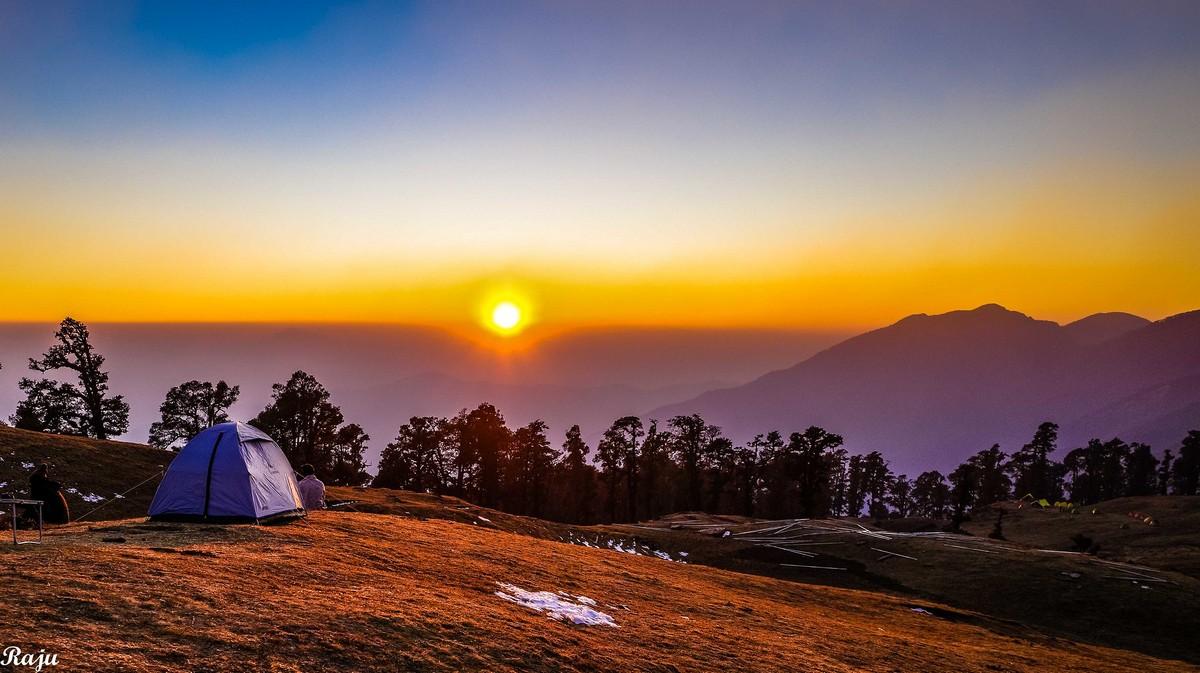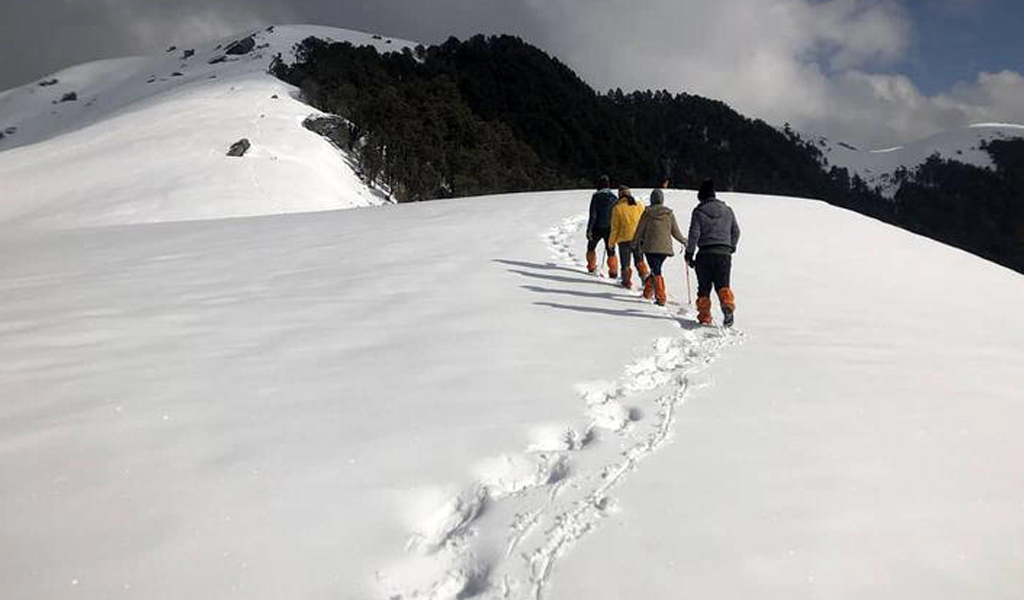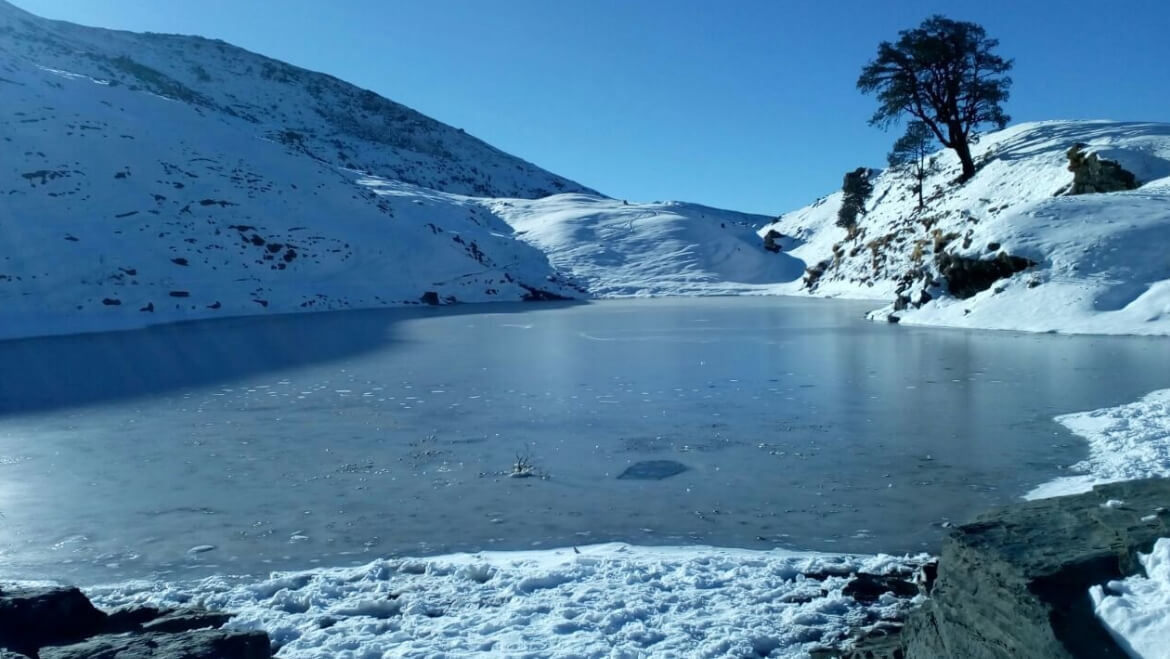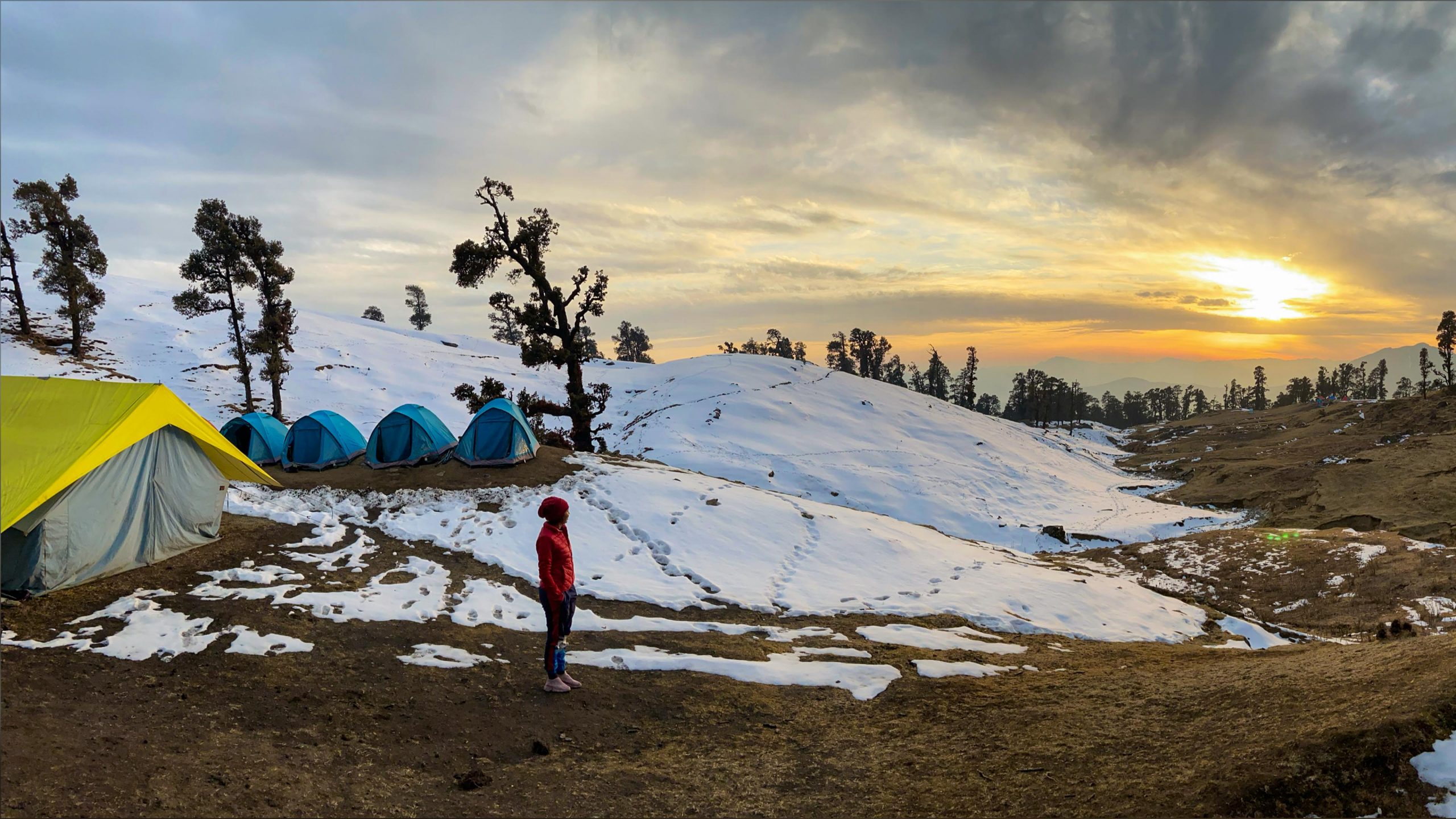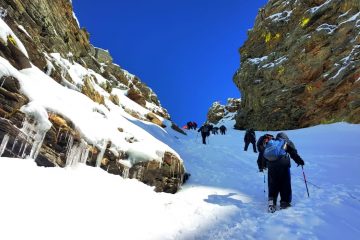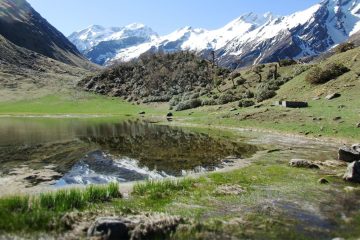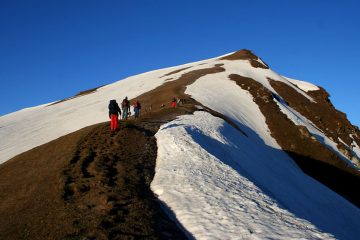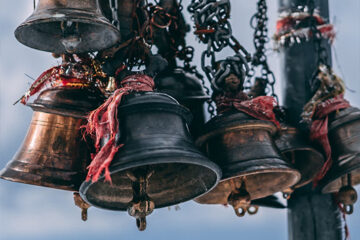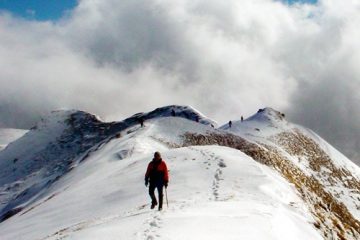Another jewel of the Himalayas which is untouched by trekkers around the world is the Brahmatal trek, which is devoted to Lord Brahma. It is beautifully positioned amidst the Himalayas and covered with blankets of snow. The trail allows you to see the centuries-old forest of Oak and Rhododendron. Walking in meadows besides Brahamatal Ridge you can see many sites of Roopkund Trek. A glance at the Garhwal Mountains in the distance on a clear day will totally melt your heart.
Resting in the depths of the Uttarakhand Himalayas, the Brahmatal trek treats you to soaring views of some lofty mountain peaks such as Mt. Trishul, Mt Nanda Ghunti and Mt. Khamet. At an altitude of 3800 m, the Brahmatal trek is open throughout the winters when most of the other trekking routes are closed making it a perfect winter trek for beginners.
Brahmatal hosts one of the loveliest forest walks that are home to diverse bird species and century old oak trees. During spring, the trails of these forests are carpeted in the red and pink blooms of rhododendrons. In winters, the landscape transforms dramatically sheathing the region in pristine white snow, making it nothing short of a Winter wonderland.
Spanning over 28 km, the Brahmatal trek begins from the base village of Lohajung located in the Chamoli district in Garhwal Himalayas. The 6 km trek from Lohajung to the Gujreni campsite runs through dense forests of Conifer, Cedar, Oak and Fir. The Gujreni campsite is at the heart of a beautiful clearing surrounded by Oak and Rhododendrons with panoramic views of snow-capped ranges.
The next day, the trek gradient increases gradually. A 2-hour trek will lead you to the Bekaltal lake, frozen during the winter months, making up for a tranquil view.
The trail heading out of the lake continues to remain dominated by Oak and Rhododendron forests. You start catching glimpses of Mt Trishul through the woods from here on. The forest soon opens up to an expansive meadow, Talindi Top, that rewards you with spectacular views of Mt. Trishul and Mt. Nanda Ghunti amongst others. The ascent continues beyond this point until you reach Jhandi Top which surpasses the views offered by Talindi Top. It is a 1.5 km descent from here onwards to the Brahmatal campsite. The campsite is delightfully set at one end of a ridge, opening up to a stunning view of the blue silhouette of mountain ranges stacked layer after layer at the horizon. The Brahmatal lake is only 500 M from the campsite. According to legend, the lake is believed to be the place where Lord Brahma meditated ages ago.
Day 1 : Dehradun/ Rishikesh to Lohajung(2331 m)
Distance: 294 kms (Dehradun to Lohajung)
Duration: 11-12 hours
Trekkers will be picked from Dehradun at 6:30am in a Tata Sumo or a similar vehicle
Expected arrival time at Lohajung– 8:00 pm
BSNL/JIO network erratic
Day 2 : Trek from Lohajung (2331 m) to Gujreni/LowerBekaltal (2750 m)
Distance: 6 kms
Duration: 4-5 hours
We begin from Lohajung at 9 AM. Packed lunches will be provided for the day. The trek starts on a well-paved stone trail that heads into the forest. The Nanda Ghunti Peak can be spotted right from the beginning of the trek.
Day 3 : Trek from Gujreni/Lower Bekaltal (2750 m) to Brahmatal (3400 m)
Distance: 5 kms
Duration: 4-5 hours
The trail from the Gujreni Campsite enters a thicket of forests with a moderate ascent throughout. You will catch the first glimpse of Mt. Trishul through the towering trees here. At a 2 hour hike away, lays the Bekaltal lake lined with Oak trees all around.
Day 4 : Trek from Brahmatal (3400 m) to Brahmatal Top (3846 m) and back to Brahmatal
Distance: 6 kms
Duration: 4 hours
The trek starts early around 6AM after having a light breakfast at the campsite. This day of the trek is the most fascinating visually and the terrain is relatively easy to negotiate. There is also the added advantage of leaving the backpacks behind at the campsite since we will be returning here for the night
Day 5: Trek from Brahmatal (3400 m) to Lohajung (2331 m)
Distance: 11 kms
Duration: 7-8 hours
After having a scrumptious breakfast, we begin the descent back to Lohajung at 8 AM following the same route as the ascent. Be prepared for a long day of trekking.
Day 6:Drive to Dehradun
After breakfast, we will be starting for Dehradun at 9AM. The journey will once again take you through the three confluences of Karnaprayag, Rudraprayag and Devprayag. Expect to reach ISBT Dehradun by 8PM.
Day 1- Dehradun to Lohajung
We begin our journey to Lohajung from ISBT Dehradun latest by 7 AM. It is located at a distance of 294 km from Dehradun and would take about 11-12 hours to cover. The landscapes throughout this drive are striking.
The journey begins with a drive uphill that will take you through the Kumaon region into the Himalayan Belt of Garhwal. The roads here are extensive and the Shivalik ranges can be spotted at the horizon. The setting is tranquil and the Ganga river accompanies you swiftly throughout this stretch.
It gets exciting after this. We will be passing through three of the five iconic confluences of the Alaknanda river (Devprayag, Rudraprayag and Karnaprayag) on the way to Lohajung.
A beautiful showcase of tradition, Devprayag, is the first confluence we will be passing by. It is the converging point of the Bhagirathi and Alaknanda rivers. You can clearly see the turquoise of one merging with the teal of the other in the valley below.
40 kms from this point, we reach the historic town of Srinagar on the banks of Alaknanda. The Rudraprayag lies further ahead from here. It is the confluence of the Mandakini and Alaknanda rivers.
About 33 km from Rudraprayag is the third confluence of Karnapraya, the meeting point of the Alaknanda and the Pindari River. Each confluence is unique in its setting and is a delight to behold!
Lohajung, located in the Chamoli district of the Garhwal Himalayas, is 86 km from Karnaprayag. Expect to reach Lohajung by late evening around 8-9pm.
Day 2-Trek from Lohajung to Gujreni
The trek begins from Lohajung central market (chowk). Move upwards from Bisht General Stores (compass direction 3000 NW) on the well-marked, human-made trail. Walkthrough the upper region of Lohajung and then through the forest trail with a few more houses. After a short trek, spot Mandoli village on your left.
As you climb higher, on your left, you will be able to see the Kali Valley, where Kali and Pindari Rivers join. Follow the water pipes that supply water to Lohajung, as they lie along the trek trail. After some time, cross a small cluster of homes called Budla, on the left. Here, you will find rhododendron trees, which make this part of the trail very beautiful from February to March.
At approx 8,500 ft, you will find a 10-metre bridge (known as Link-gaad), which will help you cross the stream. After around two hours, you will reach Begum, where you can rest for some time. This place provides splendid views of Navali Bugyal (145o SSE) and Bagdi Bugyal (125o SE). After 10-15 minutes of walking from Begum, you will find another stream. From here, an hour’s walk will bring you to the Gujreni stream.
During winters, you camp at Gujreni.
Day 3-Trek from Gujreni/Lower Bekaltal (2750 m) to Brahmatal (3400 m)
The trail from the Gujreni Campsite enters a thicket of forests with a moderate ascent throughout. You will catch the first glimpse of Mt. Trishul through the towering trees here. At a 2 hour hike away, lays the Bekaltal lake lined with Oak trees all around.
The color of the water is mud-brown indicating a high amount of dissolved organic matter. During the peak winter months, the lake is likely to be frozen. You can spend some time here immersing in the profound silence of this setting.
The trail dives straight into dense Oak and Rhododendron forests with a steep incline for the next hour. As you walk higher, you will see an idyllic view of the Bekaltal Lake retreating slowly below. The canopy of the forests is almost impenetrable, keeping most of the sunlight out. This allows patches of snow to sustain on the trails even in early spring season.
After an hour or so, the forest opens up to a spectacular meadow, called Talindi Top which offers some phenomenal views of Mt. Trishul and Mt. Nanda Ghunti. 1 km from here is the Jhandi top that sets a stunning vantage point surpassing the views offered earlier at Talindi Top. With the skies wide open and several layers of jewel-blue mountains decked one over the other, the spectacle is absolutely surreal to behold.
Jhandi Top marks the highest point on the ridge. The trail begins to descend beyond this point. The Brahmatal campsite is only 1.5 km of a downhill trek on the ridge from here.
After you reach the campsite, you can visit the Brahmatal Lake which is only 500m from the campsite. The Brahmatal lake is believed to be the place where Lord Brahma meditated long ago. This lake is completely frozen during winter season and is a marvel to behold.
One can go out and explore the beautiful photography options available at this place. Be prepared for subzero temperatures that could fall even below -7 degree Celsius during peak winter nights.
Day 4-Trek from Brahmatal (3400 m) to Brahmatal Top (3846 m) and back to Brahmatal (3400 m)
The trek starts early around 6AM after having a light breakfast at the campsite. This day of the trek is the most fascinating visually and the terrain is relatively easy to negotiate. There is also the added advantage of leaving the backpacks behind at the campsite since we will be returning here for the night.
During the winter season, your trek leader will provide you with microspikes and gaiters depending upon the snow conditions.
20 minutes into the trek, you will come across the Brahmatal lake tucked into the middle of a lush clearing. The trail till the Brahmatal lake is a steep incline climbing steadily through open grasslands. In the winter season, this area is usually covered in a sheath of white snow making it no less than a Winter Wonderland while the lake glistens under the morning sunshine.
Beyond the lake, the trail ascends moderately and envelopes into a ridge. You will notice the Brahmatal lake retiring in the valley below as you steadily gain altitude. The first ridge is a stretch of gentle ascent that leads you to the final ridge climb.
The final ridge eventually opens up tp a breath-taking spectacle of snow-capped mountain ranges standing so close to you that you feel like you are watching them on a theatre screen. Try spotting Mt. Trishul, Mt. Nanda Ghunti, Mt. Chaukhamba, Mt. Neelkanth, Mt. Kamet and Mt. Hathi Ghoda amongst the ranges.
Although Mt. Trishul and Mt. Nanda Ghunti accompany you throughout the trek, the close-up view from the summit is still thrilling to behold. Spend some time at the top immersing in the experience before heading back to the campsite
Day 5-Trek from Brahmatal (3400 m) to Lohajung (2331 m)
After having a scrumptious breakfast, we begin the descent back to Lohajung at 8 AM following the same route as the ascent. Be prepared for a long day of trekking.
The trail runs through thick Oak and Rhododendron forests. Eventually, you will come across little Shepherds huts which the locals use to keep their livestock. Following the man-made stone trail beyond that point, you will be descending to the mountain villages leading to Lohajung.
Expect to reach Lohajung in about 7-8 hours. You can then explore the slow and peaceful life at the village and learn about the various legends around the area. Do not miss the sunset in the evening. The orange rays brushing the Mt. Nanda Ghunti peak gently is lovely to watch. This is followed by a piping hot dinner at the guest house.
Day 6- Drive to Dehradun
After breakfast, we will be starting for Dehradun at 9AM. The journey will once again take you through the three confluences of Karnaprayag, Rudraprayag and Devprayag. Expect to reach ISBT Dehradun by 8PM.
In case, you plan on traveling back to Delhi the same night, consider booking a bus that starts at around 11-12 PM to account for any delays we might encounter on the way.
By Air :-
Dehradun’s Jolly Grant Airport is the airport serving Dehradun, located approximately 25 km from the city. There is a daily flight from Delhi to Dehradun. Come at some point early if you are making plans to return home via flight.
By Train :-
Take a one-day trip from Delhi to Dehradun.
- Nandadevi Express – Train no: 12205 (Departure 11:50pm; Arrival – 5:40am)
- Dehradun Express – Train no: 12687 (Departure – 9:10pm; Arrival – 5:00am)
By Bus:-
There is a normal bus provider from Delhi to Dehradun and from Delhi to ISBT Kashmere Gate. We would recommend you take the most effective government buses from ISBT Kashmere Gate. Private buses ply from outdoor ISBT and they’re now no longer agreeable with worthiness. Usually, buses drop you at Dehradun ISBT. From there, you need to come to Dehradun Railway Station.
Includes
- Meals during the trek
- Transportation from Dehradun to Lolajnag and back to Dehradun.
- Dinner on arrival day in Lohajung.
- Forest Permits/Camping Charges (only if availing transportation through A1 Himalayas). Included only up to amount charged for Indian Nationals.
- Tents, Sleeping bags, mats.
- Safety Equipment includes static rescue rope, seat harness, carabiners, pulleys.
- Trek guide, cook, helpers, porters & mules for carrying common luggage.
- Services of a Certified Trek Leader.
Excludes
- Meals during road journeys
- Carriage of Personal Bags during the trek
- Any kind of Insurance
- Any expense of personal nature
- Any expense not specified in the inclusion list.
Note :
Normally a1himalayas expect to carry your personal luggage on your own, if you wish to offload your backpack, you can give it to Mule.
Charges of offloading backpack:- Contact Us
The backpack cannot weigh more than 11 kgs. Backpack should have waterproof cover. Suitcases/strolleys/ bags will not be allowed.
Paying the Trek /Tour fee:
The fee can be paid by online transfer/Check deposit/Cash deposit/Demand draft. Instruction for payment will be forwarded along with your confirmation email. When your transfer is done, please e-mail us a confirmation mail with your transfer details, so that we can follow up your reservation efficiently.
1) Trekking Shoe/Snow Shoe
2) Rucksack/Back Pack
3) Rucksack cover (Waterproof)
4) Daypack/Knapsack
5) Undergarments/Innerwear
6)Woolen socks
7) Woolen gloves
8) Waterproof gloves
9) T-shirt
10) Trek pants
11) Camp sandal
12) Balaclava/Woolen skull
cap/Monkey Cap
13) Sun cap/Wide-brimmed
Hat/Bandana
14) Walking Sticks/Trekking
Poles/Ski Poles
15) Heavy Jacket
16) Windproof Jacket/Wind
Cheater
17)Raingear/Poncho/Waterproof clothing
18) Water bottle/Hydration pack
19) Sunscreen lotion
20) Sunglasses
21) ChapStick/Cold &
Moisturizing cream
22) Toothbrush and toothpaste
23) Towel
24) Hand sanitizer
25) Tissue roll ( Toilet)
26) Anti Fungal Powder
27) Torch/Head Lamp with extra batteries
28) Knee cap
29) Camera with extra cells
30) Dry food items
31) Personal first-aid kit
32) Medicines (This is a simple
guide line and a doctor’s
consultation is recommended.)
Altitude is a risk. Before you begin the trek, you should be aware of the effects of high altitude on your body. Acute Mountain Sickness (AMS) symptoms include a moderate headache, nausea, and overall discomfort.
Reponse: If you have any of these symptoms, notify the trek leader immediately and follow his advice. To deal with the scenario, each campsite contains a stretcher, a fully prepared first aid kit, and oxygen cylinders.
Weather Risk : No one can guarantee snow, rain, or sunlight, even if we keep a constant eye on the weather. Please keep in mind that your safety is our primary priority, and if the weather isn’t cooperating, we won’t leave the campsite.
Response: The choice to go or wait for better weather will be made solely by the Trek Leaders and Guides.
Risk: Injury is a possibility. While trekking across difficult terrains, minor injuries such as calf sprains, bruising, and other minor ailments are prevalent. Serious injuries, such as fractures or significant cuts, are quite uncommon.
Response: All of our Trek Leaders are trained in wilderness first aid. They’ve been taught to deal with emergencies and have a well-stocked first-aid equipment to deal with minor injuries. In the event of major injuries, the patient is carried to the nearest road-head on a stretcher and taken to the nearest medical facility.
DO’S AND DON’TS ON A TREK
1. Alcohols or any other intoxicating products ‘’STRICTLY PROHIBHITED’’
during the trek.
2. Always pay heed to the trek guides or instructors.
3. Try not to leave the group under any circumstances.
4. Avoid trekking during the nights as it is extremely dangerous.
5. Avoid using earphones as that might hinder your hearing.
6. Do not participate or encourage littering of the places in any form.
7. While visiting the local villages and tourist sites, obey the local guidelines
and instructions.
8. Do not harm or interrupt the local sentiments of the places.
IMPORTANT:
Your safety is of paramount concern while traveling with A1 Himalayas.
Please note that your leader has the authority to amend or cancel any part of
the itinerary if it is deemed necessary due to safety concerns. Since adventure
entails traveling in remote mountainous regions, we cannot guarantee that we
will not deviate from it. Weather conditions, health condition of a group
member, unexpected natural disasters, etc., can all contribute to changes in
the itinerary. The leader will try to ensure that the trip runs according to plan,
but please be prepared to be flexible if required.

